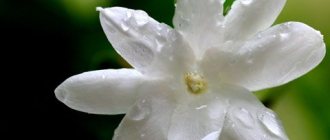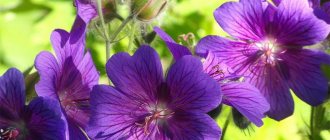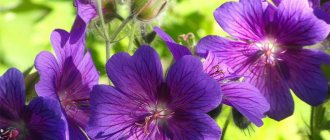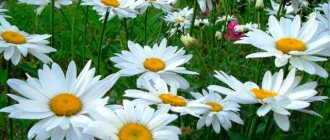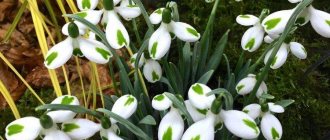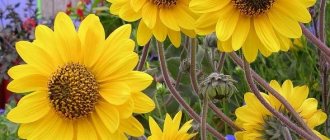Description
Campanula garden is undemanding to growing conditions and grows in a variety of places - forests, steppes, rocks and wastelands.
The flower's homeland is the Mediterranean countries; it grows well in regions with a temperate climate - in Asia, North America, and the Caucasus. The plant is herbaceous, perennial, the stem can be straight or creeping, up to 1 m long. The leaf blades on long cuttings are heart-shaped, about 7 cm long. The shape of the inflorescences is pyramidal. Flowers up to 4 cm in diameter, various shades: white, purple, blue, pink, etc.
The flowering phase begins in June and ends in September.
Campanula garden is a perennial, moisture-loving crop that requires regular watering, especially during the active growing season and flowering phase. The soil must be drained so that water does not stagnate, as the root system may rot. If you remove faded flowers from the bush in a timely manner, you can activate and stimulate the formation of new buds. In October, the stems are cut off and the root system is insulated with fallen leaves or peat.
Daily care for Campanula
Caring for bells at home is quite simple and the main conditions that must be met are:
- regular watering;
- temperature regime;
- daylight hours.
However, during long-term cultivation, it is worth thinking about other activities - pruning and replanting flowers, fertilizing and spraying the plant. Let's look at how to properly care for Campanula at home.
Bells with flowers of two shades - white and blue, are popularly called “bride and groom”. Only Campanula equifolia can have this color.
Fertilizing the plant
Bells need fertilizing during the period of active growth and flowering from March to August. During this period, feed the plant with fertilizers for ornamental flowering plants 2-3 times a month. You need to use small dosages or heavily dilute the fertilizer with water. In winter, fertilizing is not needed.
Spraying leaves
It is advisable to spray campanula leaves only in the summer, when the flower suffers from the heat and moisture quickly evaporates from the soil. It is recommended to spray the foliage in the morning or evening, since at lunchtime the sun's rays are reflected in drops of water and can leave burns on the buds and leaves.
When choosing a campanula in a store, keep in mind that in its natural environment it can only be white, blue or purple. You should not buy flowers of non-standard colors, they may be of poor quality.
Pruning and rest period
During the cold season, Campanula begins a dormant period, when the plant gains strength for growth and flowering in the spring. Depending on the variety and conditions, it can begin from October to December.
At that time:
- Trim the flower, shortening the shoots to 10 cm in length and leaving a few buds. Repeated pruning is done in January, then 5 cm is left from the shoots. Perform pruning with a sharp blade or scissors.
- Place the flower in a cool place where the temperature can be maintained at about 15%. A good option is an insulated balcony, where the plant will receive enough light.
- Reduce watering to once every week or two. In cold soil, moisture stagnates longer, so the soil needs time to dry.
If you prune the bell at the very beginning of the dormant period, it may bloom again in December, in time for the New Year holidays. In this case, it is necessary to maintain the correct conditions for keeping the flower.
Transfer
Unlike many flowering houseplants, campanula does not require annual replanting. The pot should be changed in two cases:
- If Campanula was purchased in a store;
- If the plant has grown greatly or you plan to propagate the flower by dividing the root.
Plants in the store are planted in the simplest and thinnest “transport” pot without a tray, which is not suitable for long-term cultivation.
How to transplant Campanula? Let's look at it step by step:
- Water the plant a little 4-5 hours before the planned replanting - this will make it easy to remove the root part from the pot;
- Choose a good pot with a tray - it should be 2-3 cm larger in diameter than the previous one;
- Prepare soil from peat and leaf soil, a mixture for drainage, fertilizer;
- Remove the campanula by lightly spinning it in the pot and without separating the roots from the earthen ball;
- Pour drainage into the pots (approximately 1-2 cm), partially fill it with soil;
- Place the campanula in a pot and cover the roots with soil;
- Water the plant - the soil will soften and fill the voids between the roots;
- Place the bellflower in a shaded area for a few days and limit watering.
Kinds
Campanula lactiflora
Campanula lactiflora
The plant is perennial, with a branched stem about 90 cm long, light-loving. The diameter of the flower is about 3 cm, the shade is milky or lilac, the inflorescence is pyramidal.
Carpathian Campanula (Campanula carpatica)
Carpathian Campanula (Campanula carpatica)
In nature it grows on the slopes of the Carpathians and Central European calcareous rocks. Decorative, unpretentious, long-flowering frost-resistant crop. The height of the bushes is about 40 cm, the stems are mostly erect, the shoots are covered with villi, branching. The plastic sheets are green in color, slightly hairy, with veins, rounded and heart-shaped. The flowers are large, single, cup-shaped, about 5 cm in diameter, blue, white or purple in color, formed on the tops of stems and branches.
The flowering phase begins in mid-summer and ends in autumn. Used in the design of rock gardens and balconies.
Campanula persicifolia
Campanula persicifolia
The plant is up to 95 cm high, the leaf blades are similar to peach leaves, the flowering phase lasts all summer, the flowers are blue or white.
Campanula trachelium
Campanula trachelium
The stem is branched, straight, its height is about 1 m. The flowers are large, white or light purple. Blooms profusely until late summer. Leaf blades are jagged and rough.
Pozharsky's bell (Campanula poscharskyana)
Pozharsky's bell (Campanula poscharskyana)
The leaf blades are round in shape, the shoots are creeping, long, the flowers are small, up to 2.5 cm in diameter, bright lilac in color. Cold-resistant and shade-tolerant plant.
Bluebell (Campanula glomerata)
Bluebell (Campanula glomerata)
The plant is about 60 cm high, the stem is erect, sparsely bristly. The root system is fibrous, the leaf blades are alternate, smooth on top, bristly on the reverse side, elliptical in shape. The flowers are bell-shaped, blue in color, and the inflorescence is spherical. The plant is undemanding to soil conditions and frost-resistant.
Bluebell (Campanula latifolia)
Bluebell (Campanula latifolia)
It can grow up to 120 cm, the root system is well developed, growing up to 15 cm in length. The leaf blades are ovate, slightly pubescent. Lilac flowers.
Campanula medium
Campanula medium
Height up to 1 m, branching stem, basal leaf blades have a lanceolate shape, narrow sessile leaves are located on the stem. The flowers are large, up to 7 cm in diameter, located along the length of the stem. They bloom alternately, the flowering phase lasts 60 days. The shape of the flowers is bell-shaped or goblet-shaped.
Growing a flower at home
- Light. Bright and diffused, like on a western or eastern window sill. You can also keep the campanula on the south window, but in such a way that direct sunlight does not fall on it at midday (for example, you can stick a film or a piece of tulle on the glass). It’s even better to place the flowerpot near the window, and hang openwork tulle between it and the light.
- Temperature. From spring to mid-autumn the room should be between 20 and 22 degrees. In winter, the bell prefers to freeze at 14-12 degrees.
- Air humidity. In this regard, the flower is not demanding at all. But still, in the fall (when the batteries are working) and in the summer (during the hottest weeks), the bush can be sprayed. It is better to do this late in the evening, using room water or lukewarm water.
- Watering. From spring to early autumn, Campanula needs abundant or frequent watering. In winter, even if the plant is kept cool, the soil in the pot should not dry out 100%. Water it gently every 2-4 weeks. In any case, it is better to defend the water from the tap.
- Nutrition. For bluebells, you can buy complex mineral fertilizers for decorative flowering crops. In spring and summer, such “cocktails” can be diluted twice a month. In the first month of autumn, the plant can also be carefully fed. You can't feed it in winter.
Diseases and treatment
Most often, owners of indoor campanula are faced with the appearance of gray rot. To prevent it from appearing, the flower must be grown in a pot with drainage holes in the bottom and a thick layer of expanded clay (sea pebbles, polystyrene foam). And if the flowerpot is already sick, you can fight for it by treating it with a fungicide.
Transplantation, choice of soil and pot
Campanula is replanted in early spring, when it is just beginning to wake up after winter.
Priming. Loose, light: coarse river sand + deciduous (garden) soil + humus + peat (all components are taken in approximately equal quantities).
Pot. It should be wide, with drainage holes in the bottom and a tray.
If the flowerpot is old, you don’t have to bother with replanting, but cut (pull) healthy cuttings and root them, growing yourself a new lush bush.
When can you replant a newly purchased flowerpot? It is advisable to do it quickly (it probably grows in “empty” soil, stuffed with horse-doses of fertilizing, and maybe even salts, because in many stores they water flowers with whatever they get). However, first let the pot move away from the move and adapt to the lighting and temperature of your home. That is, do not touch it for at least a week, but two is better. And only after that replant.
Flower pruning
When preparing the bush for autumn rest, you need to remove dry inflorescences.
In addition, it is advisable to shorten each shoot by 10 cm.
In spring, it is better to cut the shoots again, this time more radically, leaving only 5 cm. If the shoot is dry, shorten it completely. Dormant buds hiding near the base of the shoots will give rise to fresh branches. They will delight you with flowering in the summer.
Dormant period of indoor campanula
It begins after flowering, when the bush is “decorated” with completely dried inflorescences. That is, the flowerpot should rest somewhere from October to December, for 2 months.
You will learn 5 secrets of successful wintering (pruning, proper watering and air temperature) from this video:
https://youtube.com/watch?v=JbCl0AzhmZ8
Features of cultivation
When growing a plant, you need to consider several features:
- It is necessary to promptly remove dried flowers. This stimulates the formation of new buds, so flowering will be abundant;
- in October, the stems need to be cut, and then the root system should be insulated with fallen leaves and peat;
- tall varieties should be tied up so that they do not bend or break from gusts of wind;
- the bush is renewed annually by planting new cuttings;
- if the leaf blades begin to turn yellow from too bright rays, the bush must be shaded.
Selecting soil and planting location
The area should be well lit and protected from gusts of wind. The soil solution is neutral or slightly alkaline. The soil must be drained; before planting, it must be dug up and weeds removed.
Fertilizers and fertilizers
During the active growing season (spring-summer), the plant is fed with nitrogen-containing microfertilizers once every 14 days. After flowering, phosphorus-potassium fertilizers are applied.
Watering
The soil should be well moistened; it is recommended to water the garden campanula daily. In autumn, the amount of watering is reduced.
Loosening and weeding
Weeding is carried out regularly to prevent the growth of weeds that negatively affect the development of the plant. After watering, the soil needs to be loosened to provide the roots with oxygen.
Transfer
The plant does not tolerate transplantation very well. If it still needs to be done, it is best to do it at the end of August. Campanula garden should be replanted together with a ball of earth so as not to damage the root system. The prepared hole in the soil is watered with water, the plant is placed in it and sprinkled with soil.
Trimming
In the second year of life, Campanula garden forms several peduncles. This can cause depletion of the plant, so excess flower stalks are cut off. In mid-autumn, cut off the above-ground part of the bush, leaving 10-15 cm.
Wintering
The plant is pruned, the roots are insulated with fallen leaves or peat.
Diseases and pests
Campanula is resistant to diseases and pests. However, if not properly cared for, it can be affected by spider mites, scale insects, aphids and scale insects.
Common diseases include gray and root rot. If signs of illness are detected, a number of urgent measures should be taken:
- remove damaged parts of plants;
- reduce the number of waterings;
- carry out treatment with fungicidal agents: “Fitosporin”, copper sulfate, “Fitolavin”.
To combat insect pests, plants should be systematically inspected, as well as preventive treatment with a solution of laundry soap or tobacco chips and insecticidal preparations.
Reproduction methods
There are the following methods for propagating garden campanula:
- dividing the bush - carried out in May or August. The plant is dug up, divided into several parts, each of which consists of an underground and above-ground part, and has growth points. Then the divisions are planted in the prepared recesses. If the size of the bush is large, small parts are cut off from it with a sharp shovel, which are then planted in the chosen place;
- cuttings - in June, cut off an annual peduncle, plant it in loose soil, and shade it. In about thirty days it will take root;
- seeds - collected when the capsule turns dark brown. The seed material is dried, sown in open soil in the fall, lightly sprinkled with soil, and watered. In spring sprouts appear. When they grow up, they are transplanted into a prepared hole in a permanent place.
Is it possible to plant in open ground?
With the onset of warmth, pots are placed outside (if the flower is grown as an annual), or campanula is transplanted into the ground; it feels great in the fresh air.
What should the soil be like?
Outdoor campanula loves peaty soil mixed with foliage. The advantage of such a substrate is that it is easy to loosen and allows a large amount of air to penetrate to the roots.
Healthy. It is best to replant bluebells in spring or autumn. Transplantation is a simple process, but very important, so you need to approach it with all responsibility. It is necessary to plant in a new pot or on a new territory, maintaining all the requirements of the plant.
A layer of drainage is laid out at the bottom, then a layer of fresh loose soil, then a plant with lumps of earth on the roots is placed in the center of the pot (hole). You should not wash the “old” soil - this will make it easier for the flower to adapt. At the end of the transplant, the remaining soil is filled in, lightly compacted with hands, and the earthen ball is watered.
Possible problems
If you do not follow the basic rules for caring for garden campanula, some problems may arise:
- for planting you need to choose a well-lit area, otherwise the growth of the plant slows down and the stems stretch;
- the soil must be drained so that moisture does not stagnate and the roots do not rot;
- it is necessary to water the bushes in a timely manner so that the soil does not dry out and the plant does not suffer from water deficiency;
- the soil needs to be loosened, the root system needs oxygen.
Watering and fertilizers
Campanula is a moisture-loving plant. Especially during the period of growth and flowering. Water the flower daily with small portions of water. In especially dry summers, watering can be increased to 2 times a day (morning and evening). Overdried soil can destroy a plant in a few days.
Use heated water for irrigation. Carefully monitor soil moisture. Stagnant water is just as detrimental to bells as drought. In autumn, gradually reduce the watering process.
Recommendations for fertilizing the flower:
- The perennial needs feeding in spring and summer.
- Campanula does not tolerate fresh manure; this type of fertilizer leads to rotting of the roots.
- It is not advisable to fertilize more often than once every 2 weeks.
- Apply nitrogen-containing fertilizers to the soil in early spring.
- Before flowering begins (presumably in May), fertilize the bell with minerals.
- After flowering, the perennial can be fed with potassium and superphosphate.
Campanula garden in landscape design
When decorating borders, rockeries, flower beds, and ridges, low-growing varieties are used, combining them with other flowers (for example, fern or mallow). Campanula garden looks good in the middle of a flower bed and as a carpet plant.
The plant is undemanding, responsive to care and attention paid to it. Plant several different varieties in your garden and enjoy their blooms from early summer until autumn.
Rules for planting and transplanting Campanula
Perennials can be planted and replanted in spring or autumn.
Flower propagation occurs:
- By cuttings. Cut the shoot from the bottom of the shoot with a sharp knife and place it in a container of water so that the leaves remain on the surface. After the roots appear, plant the cuttings in a pot with a peat and sand mixture. There is no need to water the sprout, just sprinkle it with water. When the cutting gets stronger, transplant it into the garden.
- Seeds. They are planted in the ground in the fall or in pots or a greenhouse in the spring. Scatter the planting material onto moist soil and cover with 3 cm of soil. Water thoroughly again. In autumn, perform the procedure at the end of October. Shoots will appear 3–4 weeks after the snow melts. In spring, plant in March. Cover the container with the seeds with glass or film and ventilate the seedlings periodically. At the end of May, the plant can be planted in the garden.
- Dividing the bush. Dig up the mother bush at the end of summer or in September and divide it into 2-3 parts. Make sure that each has at least 1 resume point. Plant part of the root in a permanent place. Before the onset of frost, the seedlings will have time to take root.
Where to plant or transplant Campanula:
- First of all, prepare a place for future planting/transplantation. The ground should be dug up and cleared of weeds (dig them up by the roots).
- The area should be illuminated by diffused sunlight. Partial shade is allowed.
- Choose a place without drafts.
- The preferred soil composition is alkaline or neutral. Add peat and sand to clay soil, and humus and wood ash to sandy soil. The main thing is that the soil is loose, allowing the roots to breathe.
- Avoid lowlands and other areas with constant stagnant water.
To avoid damaging the roots, do not shake the plant or knock off the soil. Fill the pre-dug holes with water, place a bell in them and sprinkle soil on top.
Brief conclusions
- Campanula garden is a flower of which there are about 300 varieties. Such a variety of species will make it easy to choose a plant specifically for your flower arrangement.
- To grow a crop, you need to choose the right piece of land. She needs sunlight, but diffused. Partial shade is allowed, the main thing is not strong shading, otherwise the foliage will suffer.
- Campanula bluebell requires a lot of water. Water it once a day, and during drought, double the moisture ratio. The water should be at room temperature.
- It is important to regularly loosen, ensuring the flow of oxygen to the root system. This guarantees lush flowering.
- In some varieties, in order to achieve re-budding, dried flowers should be removed in time.
- The culture needs shelter for the winter. You can provide protection to the roots using peat or fallen leaves.






